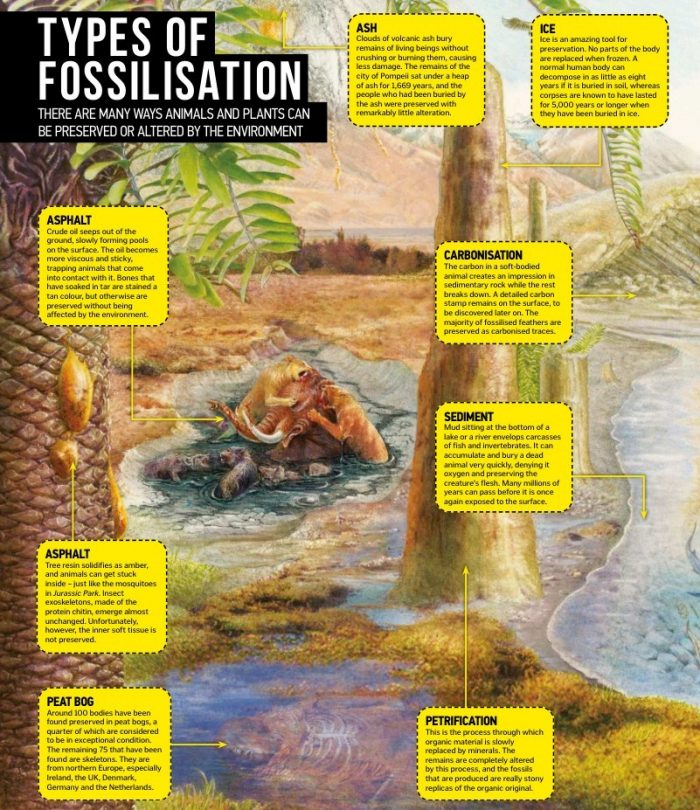
Fossilization is a natural process that occurs over millions of years. The fossilization process begins when an animal or plant dies and its remains are buried in sediment. This sediment layer protects the corpse from further decay, allowing minerals to seep into the gap between cells and tissues and form a mold around it. Over time, more sediment layers will be added on top of this original one until there’s no more room left for new fossils.
Ash Fossilization
Ash fossilization is the process of preserving organic matter in ash. Ash can preserve fossils when it is deposited rapidly and buried before decay occurs, or when volcanic activity causes tremendous amounts of heat to be released. This process involves an organism dying and being covered with a layer of ash that blocks oxygen from reaching its body. This prevents bacteria from breaking down their remains, which means they don’t decompose or disappear over time; instead, they become fossils! The plant or animal must die quickly after being buried so as not to decay before becoming fully fossilized–this usually happens when something dies during a volcanic eruption or other natural disaster where lots of debris get thrown around quickly (like an earthquake).
Ice Fossilization
Fossils can also be formed in ice. Ice is a good preservative and can preserve fossils for millions of years, as we see with permafrost and glaciers today. Examples include: The fossilized remains of plants and animals that were trapped by a glacier, then preserved when the glacier melted (like this Woolly Mammoth). A dinosaur found encased in ice from Antarctica’s frozen interior, which was discovered by scientists drilling through layers upon layers of earth (like this Antarctopelta).
Asphalt Fossilization
You may be familiar with the term “asphalt,” but do you know where it comes from? Asphalt is a type of sedimentary rock that forms when organic material gets buried under layers of sand and mud. Over time, heat and pressure cause these materials to turn into a black, sticky substance known as bitumen. This substance can be found in many places around the world, including the United States and Canada. Asphalt fossils are usually preserved in this way because they’re buried under layers of sedimentary rock before they have time to decay completely.
Carbonization Fossilization
Carbonization is the process of preserving carbon-based materials. This type of fossilization can preserve organic materials, such as wood, leaves or skin. Carbonization occurs when organic material is exposed to high heat or pressure without oxygen. The heat burns the organic matter and leaves behind only its carbon content; this results in a rock-like substance called charcoal (which we use as fuel). Carbonization can also occur when an organism dies and its body dries out before it decomposes completely–the remaining organic matter becomes hardened over time due to exposure to oxygenless conditions (for example: deep inside an oceanic trench).
Sediment Fossilization
Sediment is a catchall term for loose material that has been deposited by water, wind or ice. Sediment can be loose or hardened into rock. The most common type of fossilization occurs when sediment covers an organism and protects it from decay. If the conditions are right, the organism will become preserved in stone as minerals replace its original tissues.
Petrification Fossilization
Petrification is a type of fossilization that occurs when an organism is buried in sediment, which then hardens into rock. This process can occur in many different types of sediment and is one of the most common forms of fossilization. Petrification occurs when minerals from water or air enter the pores of a dead organism’s tissues and replace them with stone-like substances. This process can take millions of years to complete; however, it may only take months or years if conditions are right (e.g., high levels of humidity).
Peat Bog Fossilization
This occurs when plants and animals are preserved in peat bogs, which are acidic environments that form when decaying plant matter sinks to the bottom of a body of water and decomposes slowly over time. As it decays, this material becomes more acidic as well as highly carbon-rich; eventually, it turns into a very soft black substance known as peat (or “muck”). The acidity prevents oxygen from reaching the remains buried at the bottom of such an environment, which means they won’t decay further–and they may even become mineralized over time! Peat bogs can be found all over the world: there’s one right here in Massachusetts! It’s located near Wareham State Forest on Cape Cod Bay near Buzzards Bay Road; if you go there during summer months when temperatures are warm enough for water levels to drop low enough for access without getting your feet wet too much then you might find yourself standing amongst some interesting fossils including sea shells from millions of years ago!
The fossilization process is fascinating, and it can be very useful in helping us learn more about the past. We hope you enjoyed learning about the different types of fossilization!
